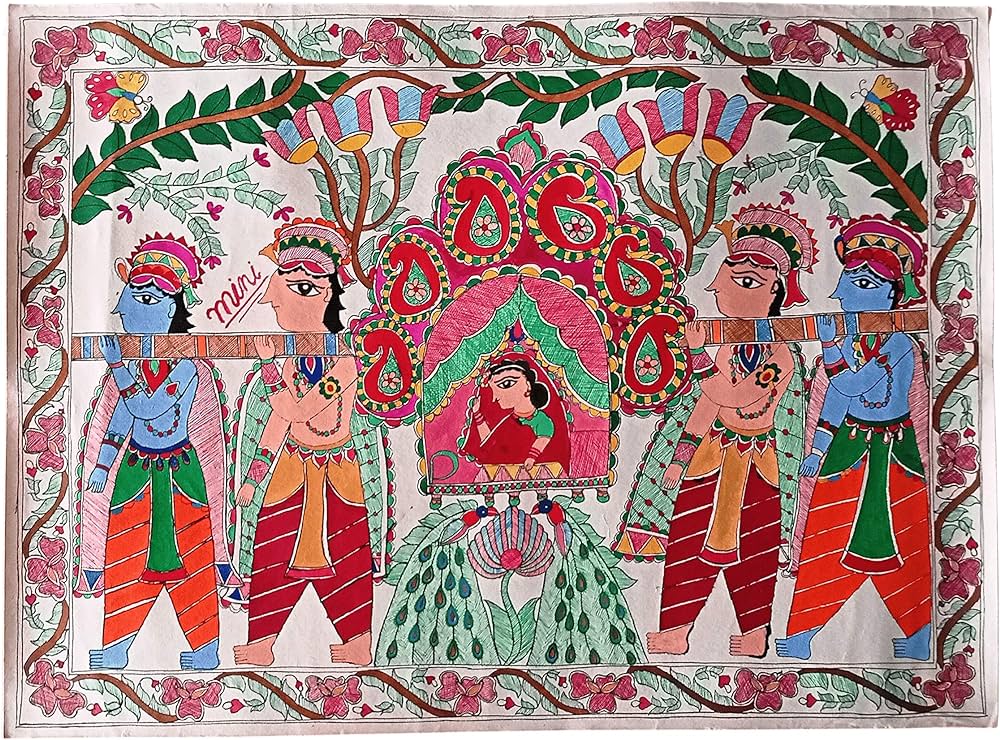
In the resplendent realm of Indian art, the Mithila paintings from the Mithila region of Bihar stand as exquisite emblems of spiritual reverence and cultural heritage. These intricate, vibrant artworks, meticulously crafted on handmade paper or cloth, weave a tapestry of narratives that celebrate the divine feminine, paying homage to the myriad goddesses who grace the Hindu pantheon. Beyond mere artistic expression, these paintings embody a deep-rooted tradition that venerates the sacred feminine energy, Shakti, as the primordial force that sustains existence.
The Mithila painting tradition, deeply rooted in the cultural ethos of the region, has been nurtured and passed down through generations of women artists. These talented creators, known as Aripan, are the custodians of an artistic legacy that transcends mere aesthetic appeal, serving as a conduit for the transmission of spiritual wisdom and the preservation of age-old mythological narratives.
At the heart of these paintings lies a reverence for the divine feminine, manifested through the depiction of a pantheon of goddesses, each embodying unique attributes and symbolic significance. From the fiercely protective Durga, slayer of demons, to the benevolent Lakshmi, bestower of wealth and prosperity, the Mithila artworks celebrate the multifaceted aspects of the feminine divine.
One of the most prominent deities represented in Mithila paintings is the goddess Ganga, the personification of the sacred river Ganges. Her depiction often highlights her life-giving and purifying powers, with intricate details capturing the flow of her celestial waters. The reverence for Ganga is deeply ingrained in Hindu spirituality, and her portrayal in these artworks serves as a reminder of the interconnectedness between the divine and the natural world.
Another goddess who features prominently in Mithila paintings is Kali, the fierce and powerful embodiment of Shakti. Her depictions often portray her in her fearsome form, with multiple arms wielding weapons and adorned with a garland of skulls. Yet, beneath her fierce exterior lies a deeper symbolism – Kali represents the ultimate triumph of the divine feminine over the forces of evil and ignorance, reminding us of the transformative power of Shakti.
Beyond the major goddesses, Mithila paintings also pay homage to local deities and folk traditions, reflecting the rich tapestry of religious beliefs and practices that have shaped the cultural landscape of the region. These representations not only showcase the diversity of Hindu spirituality but also serve as a window into the lived experiences and narratives of the communities that have nurtured this artistic tradition.
The portrayal of goddesses in Mithila paintings is not merely a matter of artistic expression; it carries profound spiritual and social significance. In Hindu mythology, the goddess figures are revered as embodiments of strength, wisdom, and nurturing energy – qualities that have historically been associated with the feminine principle. By celebrating these divine feminine archetypes, the Mithila paintings challenge patriarchal narratives and empower women, reminding them of their inherent worth and potential.
Moreover, the creation and appreciation of these artworks have traditionally been a domain dominated by women artists, further reinforcing the notion of female empowerment and agency. Through their intricate brushstrokes and vibrant color palettes, the Aripan artists reclaim their voices, asserting their creative prowess and contributing to the preservation of a cultural heritage that transcends temporal boundaries.
Beyond their religious and artistic significance, Mithila paintings hold the potential to promote gender equality and foster a deeper understanding of the divine feminine. By showcasing the multifaceted aspects of goddesses, these artworks challenge stereotypical notions of femininity and encourage a more nuanced appreciation of the complexities and strengths inherent in the feminine principle.
The narratives surrounding the goddesses depicted in Mithila paintings are often imbued with empowering messages and lessons. The story of Durga’s triumph over the buffalo demon, Mahishasura, symbolizes the victory of righteous forces over evil, highlighting the unwavering courage and resilience of the feminine divine. Similarly, the tales of Kali’s fearless battles against demonic forces celebrate the transformative power of Shakti, reminding us that the divine feminine is a force to be reckoned with, capable of overcoming even the most daunting challenges.
These empowering narratives have the potential to resonate deeply with individuals across cultures and belief systems, transcending the boundaries of religion. By recognizing the universal themes of strength, resilience, and the triumph of good over evil, these stories can inspire and empower individuals, particularly women, to embrace their inherent worth and overcome societal barriers and personal struggles.
Furthermore, the appreciation and promotion of Mithila paintings can contribute to fostering a deeper reverence for the divine feminine within spiritual and religious contexts. By acknowledging and celebrating the sacred feminine energy, these artworks challenge traditional patriarchal narratives that have often marginalized or diminished the role of the feminine principle in religious discourse.
As humanity continues to grapple with issues of gender inequality and the suppression of feminine voices, the significance of Mithila paintings extends far beyond their artistic merits. They serve as powerful reminders of the enduring legacy of the divine feminine, inviting us to embrace the sacred feminine energy as a source of strength, wisdom, and empowerment.
In an age where cultural preservation and the promotion of diverse artistic traditions are of paramount importance, the Mithila paintings stand as a beacon of hope, reminding us of the richness and depth of our shared cultural heritage. By appreciating and celebrating these intricate artworks, we not only honor the artistic prowess of the Aripan artists but also pay tribute to the enduring legacy of the divine feminine – a legacy that has the power to inspire, uplift, and transform hearts and minds across generations and cultures.
As we bask in the radiant beauty of Mithila paintings, we are reminded of the enduring splendor of Indian culture – a tapestry woven with threads of spirituality, artistry, and reverence for the divine feminine. These intricate artworks stand as a testament to the rich heritage that has flourished on the fertile shores of the Indian subcontinent, a heritage that has nurtured generations of artists, poets, and spiritual seekers.
In the vibrant hues and intricate patterns of Mithila paintings, we catch glimpses of the sacred narratives that have shaped the collective consciousness of countless souls. The depictions of goddesses, resplendent in their divine glory, serve as a reminder of the eternal truths that transcend the boundaries of time and space – truths that celebrate the indomitable spirit of the feminine principle, the life-giving force that sustains all existence.
As we immerse ourselves in the enchanting world of Mithila art, we are transported to a realm where the divine and the earthly intertwine, where the sacred feminine energy pulses through every brushstroke, every meticulously crafted line. In this realm, we are reminded of the profound wisdom that resides within the Indian ethos – a wisdom that recognizes the innate divinity within all beings, and the interconnectedness of all life.
The Mithila paintings are not merely works of art; they are portals to a world of spiritual enlightenment, a world where the feminine divine is revered and celebrated, where the goddesses stand as beacons of strength, resilience, and the triumph of good over evil. In this world, we are invited to embrace the transformative power of Shakti, the primordial energy that pulsates through the very fabric of the universe.
As we marvel at the intricate details and vibrant colors that adorn these paintings, we are reminded of the boundless creativity and artistic expression that has flourished within the Indian cultural landscape. These artworks are living testaments to the enduring legacy of the Aripan artists, whose skillful hands have given form to the sacred narratives that have been passed down through generations.
In the end, the Mithila paintings are not merely artistic masterpieces; they are living embodiments of the Indian spirit – a spirit that celebrates diversity, reveres the divine, and embraces the sacred feminine as a source of strength and enlightenment. As we bask in their radiant beauty, we are reminded of the boundless potential that lies within each one of us, waiting to be unleashed through the transformative power of art, spirituality, and reverence for the divine.
By: Vasini Shyama Charan Jha
Brief Introduction of Author: With a voice steeped in the soul of India’s folk music, she carries the vibrant legacy of a bygone era into the modern world. Her dedication spans decades, her melodies weaving tales that bridge the gap between tradition and classical mastery. Her renditions resonate deeply, captivating audiences and earning her recognition not just on All India Radio and Doordarshan, but also gracing the pages of prestigious publications across the globe – from Britain and the United States to Australia, New Zealand, and even Greece.
An empaneled artist and an inspiring teacher, she is a conduit for this cultural heritage, sharing its magic on esteemed platforms and igniting a passion for music in aspiring artists. Her mission is to inspire generations as both an artist and a mentor, ensuring that the rich tapestry of Indian culture continues to resonate for years to come.
Write and Win: Participate in Creative writing Contest & International Essay Contest and win fabulous prizes.


